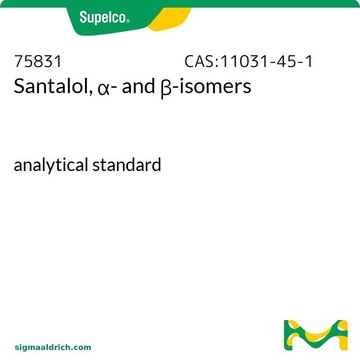Wichtige Dokumente
W300500
Sandalwood oil
natural
About This Item
Empfohlene Produkte
Biologische Quelle
Santalum album l.
Qualität
Halal
Kosher
natural
Optische Aktivität
[α]20/D −15°, neat
Brechungsindex
n20/D 1.507 (lit.)
bp
276 °C (lit.)
Dichte
0.974 g/mL at 25 °C (lit.)
Anwendung(en)
flavors and fragrances
Dokumentation
see Safety & Documentation for available documents
Nahrungsmittelallergen
no known allergens
Organoleptisch
woody; spicy; herbaceous; balsamic
Suchen Sie nach ähnlichen Produkten? Aufrufen Leitfaden zum Produktvergleich
Verwandte Kategorien
Angaben zur Herstellung
Haftungsausschluss
Signalwort
Warning
H-Sätze
Gefahreneinstufungen
Eye Irrit. 2 - Skin Irrit. 2 - Skin Sens. 1 - STOT SE 3
Zielorgane
Respiratory system
Lagerklassenschlüssel
10 - Combustible liquids
WGK
WGK 2
Flammpunkt (°F)
Not applicable
Flammpunkt (°C)
Not applicable
Persönliche Schutzausrüstung
Eyeshields, Faceshields, Gloves, type ABEK (EN14387) respirator filter
Hier finden Sie alle aktuellen Versionen:
Besitzen Sie dieses Produkt bereits?
In der Dokumentenbibliothek finden Sie die Dokumentation zu den Produkten, die Sie kürzlich erworben haben.
Global Trade Item Number
| SKU | GTIN |
|---|---|
| W300500-100G-K | 4061838093585 |
| W300500-1KG-K | |
| W300500-25G | |
| W300500-SAMPLE | |
| W300500-100G | |
| W300500-1KG | |
| W300500-25G-K | 4061838079985 |
| W300500-SAMPLE-K | 4061837518379 |
Unser Team von Wissenschaftlern verfügt über Erfahrung in allen Forschungsbereichen einschließlich Life Science, Materialwissenschaften, chemischer Synthese, Chromatographie, Analytik und vielen mehr..
Setzen Sie sich mit dem technischen Dienst in Verbindung.






